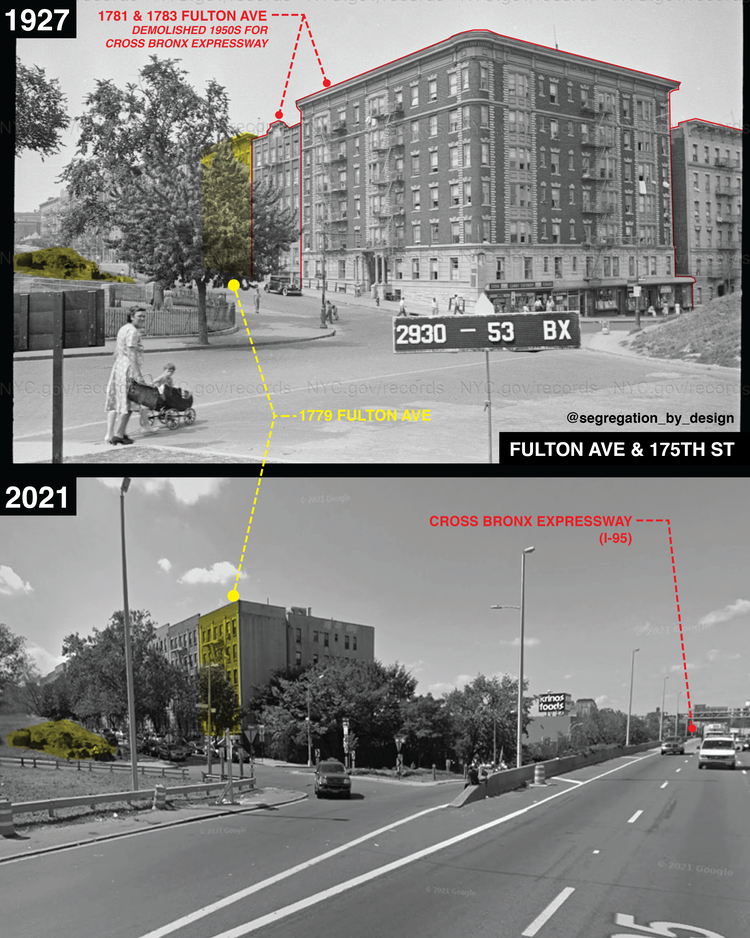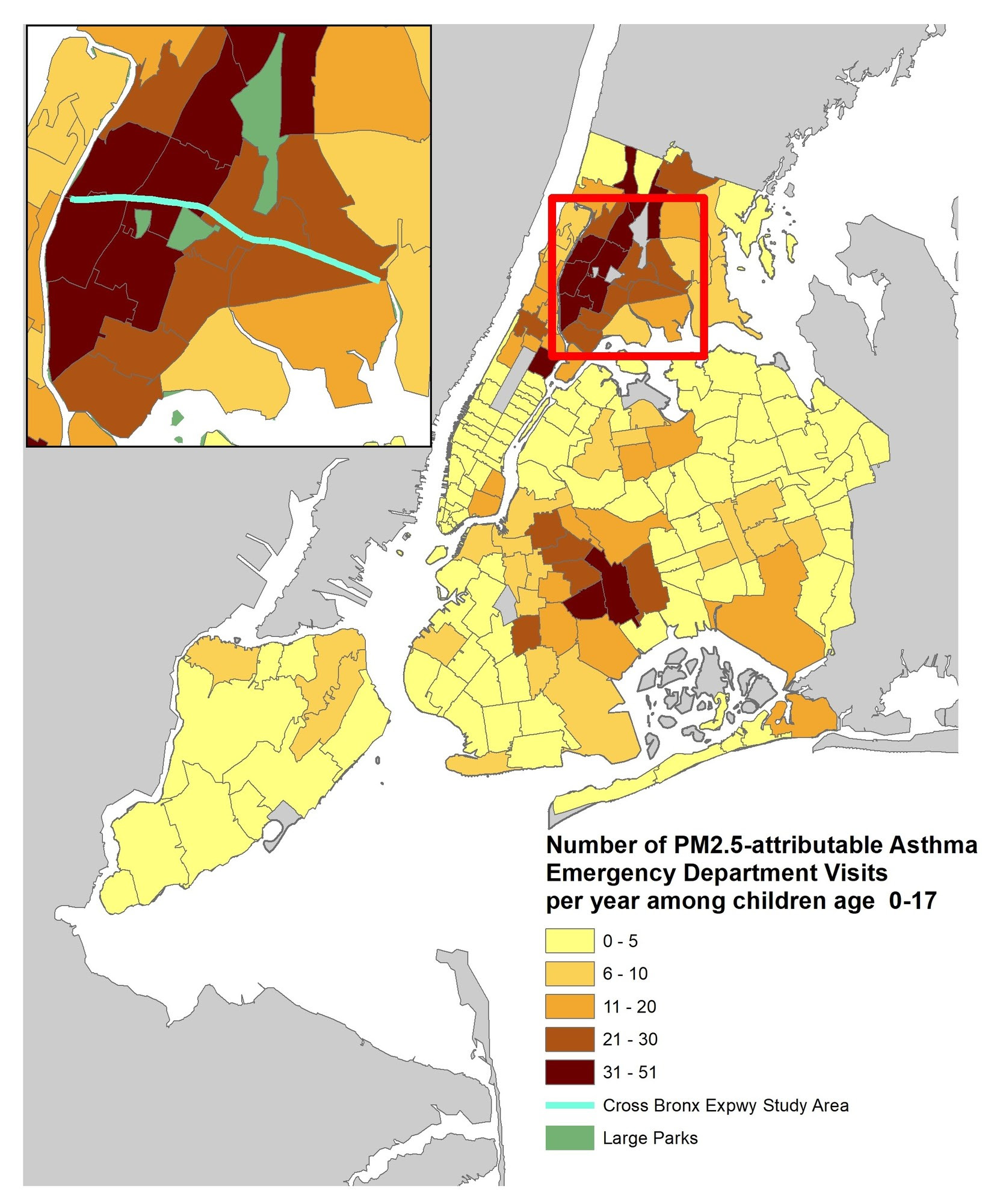Currently a Major Source of Noise and Air Pollution, Cross-Bronx Was Built to Divide Largely Black and Latino Working-Class Neighborhoods
With $2 Million Federal Grant, Community-Driven Plan Will Study Decking Highway and Identify Strategies to Reconnect Communities, Address Inequitable Health Outcomes, Expand Open Space, and Increase Safety
New York City Mayor Eric Adams today kicked off a landmark community-driven study to reimagine the Cross-Bronx Expressway, including examining the feasibility of decking sections of the highway. Constructed largely in the 1950s and 1960s, the Cross-Bronx divides the borough, cutting directly through largely Black and Latino working-class neighborhoods — devastating the local communities and economies while bringing significant noise and air pollution that, in turn, has brought elevated asthma rates and other inequitable health outcomes to local residents.
Funded by a $2 million U.S. Department of Transportation Rebuilding American Infrastructure with Sustainability and Equity (RAISE) grant submitted by the New York City Department of Transportation (NYCDOT), the New York City Department of City Planning (DCP), and the New York State Department of Transportation (NYSDOT) with the New York City Department of Health and Mental Hygiene (DOHMH), the community-driven effort will aim to redress negative impacts of the highway on surrounding communities while promoting residents’ health and well-being.
“The Cross-Bronx Expressway was a scar carved through the heart of the Bronx, turning bustling streets into ghost towns,” said Mayor Adams. “But 50 years later, we see the resilience of this great borough, and we have an opportunity to make the Bronx whole again. This historic study will allow us to reimagine the entire Cross-Bronx corridor and the communities around it, and we will look at every possible way to reduce pollution and noise, improve safety and sustainability, and reconnect the communities of this borough. Thank you to our city, state, and federal partners for helping us secure this important grant, and we look forward to bringing everyone to the table together with the community to chart a new course for the Bronx.”
“Since my first State of the State address, I have made it clear that reconnecting communities divided by infrastructure decisions made generations ago has been a top priority,” said New York Governor Kathy Hochul. “I am proud to partner with the mayor on this grant, which will support vital community engagement programming and listening sessions to help reimagine the future of the Cross-Bronx Expressway, an essential component of righting the wrongs made when the Expressway was constructed more than seventy years ago.”
A map of air pollution-driven asthma emergency department visits for children under age 18. Credit: New York City Department of Health and Mental Hygiene

“With critical support from the Biden administration — and U.S. Transportation Secretary Buttigieg and Deputy Secretary Trottenberg — we are proud to put federal infrastructure dollars to work on this critical project,” said Deputy Mayor for Operations Meera Joshi. “Reconnecting communities torn apart by discriminatory highways and improving air quality for the surrounding community are at the foundation of worthy infrastructure progress.”
Formally signed last week by participating agencies, the grant to fund the “Reimagining the Cross-Bronx Expressway” study marks an unprecedented partnership across all levels of government to help undo the damage to Bronx neighborhoods. The study will identify strategies to deck sections of the expressway and create new public open space with pedestrian and bike connections, reconnect communities north and south of the current highway, reduce vehicle emissions and address inequitable public health outcomes across the adjacent communities, improve safety on local streets and along the corridor with a focus on ramps on and off the highway, and more sustainably manage freight and other vehicle traffic.
With the two-year RAISE grant, the city and the state will:
- Work closely with residents, community groups, and stakeholders to create a common understanding about community needs, with the first round of community meetings planned to begin in February 2023;
- Create a holistic vision for the Cross-Bronx corridor and develop project ideas based on community input; and
- Present a multiyear plan, by 2024, that includes both near- and long-term project proposals to improve neighborhood conditions around the Cross-Bronx.
A vestige of the Robert Moses era, the Cross-Bronx bulldozed through the borough, destroying the homes of approximately 40,000 residents. With an average of 300 diesel trucks using the roadway every hour and tens of thousands of cars per day traveling in each direction, the 220,000 New Yorkers who live near the highway are regularly exposed to elevated levels of noise and air pollution as well as excessive heat. Communities near the highway experience elevated rates of respiratory disease, including asthma, and other chronic disease. Rates of diabetes and hypertension exceed citywide rates by up to 100 percent and 50 percent, respectively, and there are approximately 100 emergency department visits for asthma and about 25 premature deaths due to traffic-related fine particulates (PM2.5) each year.
The Cross-Bronx has also become notorious among American interstates, with some of the highest crash and fatality rates. Between 2014 and 2018, an average of 159 injuries occurred each year on streets adjacent to the expressway.
“I thank all of our partners in government for coming together to advance this critical project, which addresses so many of the issues of equity that Mayor Adams has identified as the highest priority,” said NYCDOT Commissioner Ydanis Rodriguez. “Special thanks go to Transportation Secretary Pete Buttigieg and Deputy Secretary Polly Trottenberg, who have made fixing terrible 20th-century urban highways across the country — and all of their attendant problems — such a real priority. I am confident we can fix the Cross-Bronx and make this a real legacy of our time as public leaders.”
“Building the Cross-Bronx Expressway, and dividing connected communities, has had a truly harmful effect on the people of this borough,” said DCP Director and City Planning Commission Chair Dan Garodnick. “It’s time for us to step up and find ways to correct the ills of the past and create a healthier, cleaner, and safer environment for all residents of the Bronx.”
“This landmark study will evaluate the needs of the long-underserved communities situated alongside the Cross-Bronx Expressway corridor and help us create more equitable living conditions by identifying actionable ways we can increase safety, improve access to open space, and combat noise, air, and traffic pollution,” said Chief Climate Officer and New York City Department of Environmental Protection Commissioner Rohit T. Aggarwala. “The RAISE grant came out of a productive partnership between city, state, and federal partners, and successful collaboration such as this is essential to accomplishing the generational work of environmental justice.”
“For decades, residents of the Cross-Bronx corridor have disproportionately borne the brunt of roadway bifurcation, suffering high rates of heart and lung disease due to vehicle pollution,” said Mayor’s Office of Climate and Environmental Justice Executive Director Kizzy Charles-Guzmán. “We must change that. Senator Schumer and Representative Torres have taken bold action to advance environmental health and equity while ensuring that community stakeholders are a central part of the process.”
“Good health is, in part, a function of the environments in which we live,” said DOHMH Commissioner Dr. Ashwin Vasan. “And infrastructure and transportation shape these environments in ways that can serve to promote health for all or to divide us and reinforce health and social inequities. Reimagining this stretch of the Cross-Bronx Expressway offers a chance to undo disparities created decades ago with its construction and to advance the health of our city and the great borough of the Bronx.”
“When it was built over 50 years ago, the Cross-Bronx Expressway tore apart countless neighborhoods — the beating heart of New York City — and the 6.5-mile structure was developed without community consultation nor a single mile’s worth of concern for the city’s most vulnerable residents,” said Julie Tighe, president, New York League of Conservation Voters. “Now, thanks to this $2 million federal RAISE grant and a comprehensive new study — with community perspective — we have the chance to envision a new way forward for the South Bronx. From funding to implementation, the ‘Reimagining the Cross-Bronx Expressway’ study is an inspired example of cross-government coordination, and we’re grateful for the leadership of Governor Hochul, Majority Leader Schumer, Congressmember Torres, and Mayor Adams for making it happen.”
“It is not often that we have an opportunity to reverse decades of structural and infrastructural racism that holds back our communities, neighborhoods, and local economies,” said Michael Brady, senior vice president of economic development and policy, Bronx Chamber of Commerce. “Today’s announcement to launch a landmark study to reimagine the Cross-Bronx Expressway will create a community-driven plan and identify strategies for transportation connectivity and sustainability, expand open space, and improve regional commerce. This $2 million investment by the United State Department of Transportation will provide the vehicle for change that has been demanded by our communities for decades. We are grateful for this down payment on plans to revitalize and reconnect our communities and neighborhoods in the Bronx and position our borough for future economic growth and innovation. We extend our sincere thanks to our congressional leaders and federal partners in the United States Department of Transportation.”

No comments:
Post a Comment